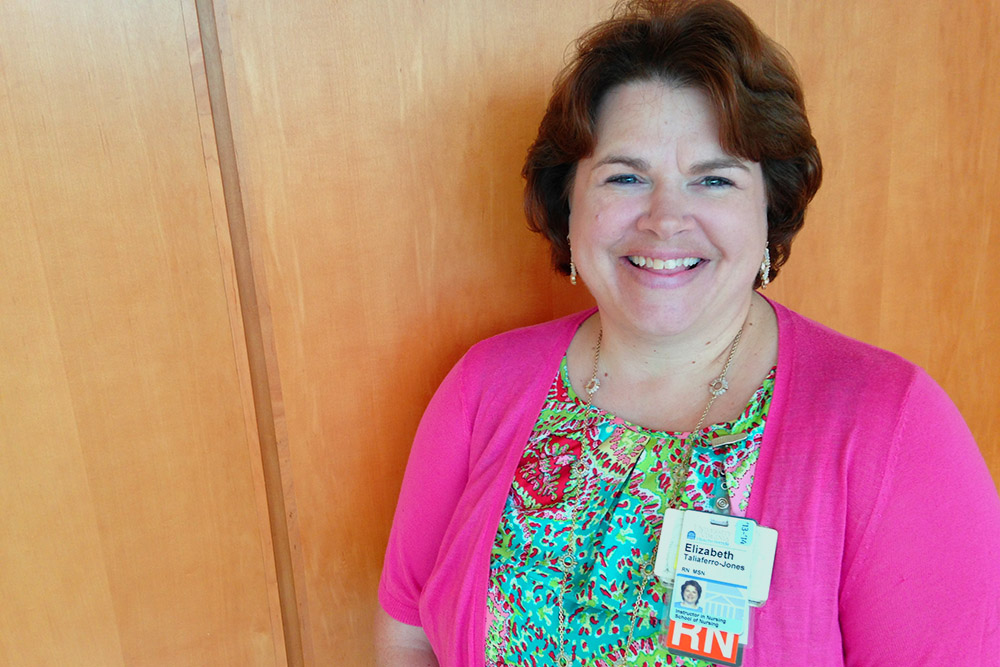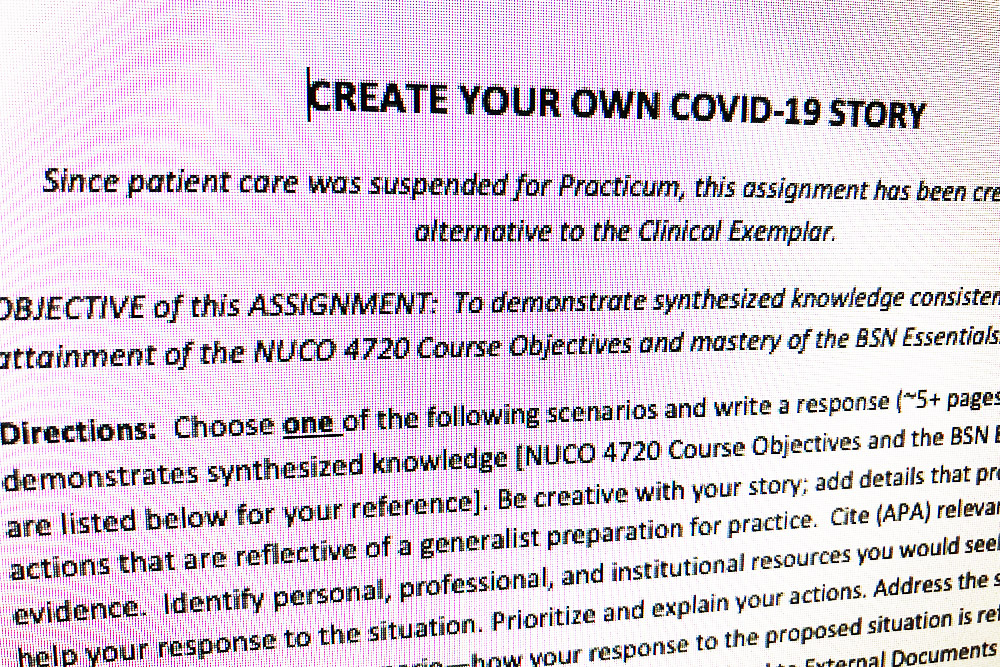On Practicum, Professionalism, and the COVID Pause

Instructor Elizabeth Taliaferro-Jones, a veteran critical care nurse, is academic clinical coordinator for both the BSN and CNL programs, and among those whose tireless work during UVA's shuttering meant that clinical learning - albeit in a new virtual form - continued. With colleagues, Taliaferro-Jones analyzed and assigned simulation software, creatively widened course topics, and did her best to make students - disappointed by the loss of their final practicum - feel cared for and heard.
Now at work organizing in-person clinical rotations for both BSN and CNL students this summer and fall, she ruminates on COVID, online learning, the power of creativity, and nursing students' professionalism, and why teaching at the bedside is perhaps more critical now than ever.
WHY PRACTICUM LOOMS SO LARGE
“Practicum [a nursing student’s final clinical rotation] is a rite of passage, and there’s so much excitement for it. They’re done with their didactic courses, and it’s the very final last step of what you need to become a real nurse before you take your boards (NCLEX exam). Yes, they have an instructor, and a preceptor in the wings, ready to jump in if they need help, but by this point, students say, ‘I’m on my own, and I can synthesize everything I’ve learned and been taught, and pull in life experience to do what I was called to do.’”
ON ITS LOSS
“We’d been planning for practicum since early September 2019 … Then the real work starts between October and the first part of December, when we’re in touch with clinical partners placing students. Usually, we’ve put things to bed by the holidays.
“This year, we alerted students about their placements January 23, then spent the next six weeks getting compliance issues in place and connecting them with preceptors. Feb 20, we met in person and I gave out big, old chocolate bars for those who stood up and gave the right answers to my questions about deadlines, assignments, how to reach their preceptors, and present their learning objectives. I’d planned for students to keep their reflective logs through video, because by fourth year, many feel all reflected out. I’d wanted to try something different, and something reflective of the generation they’re a part of. I thought I was being cool, too!

“[When COVID hit mid-March], my ICU training kind of kicked in. We dealt with what was in front of us with no emotion—except when we had to tell our students that due to concerns and so many variables, we had to cancel practicum.
“It was a heartbreak, but it was the smart thing to do. Initially, students felt a mixture of grief and shock. In many ways, it was the first time they were having to make their first real clinical judgement, and it was scary.
WHAT HAPPENED NEXT
“That week and the following, literally, the village came together to figure out the possibilities of what we could do ... [In addition to live virtual clinical simulations and software to augment clinical skills], I spent a weekend dreaming up COVID-19 assignments with different prompts, like, ‘You’re an elementary school nurse and you’ve got a case, and you’re noticing other students now have these symptoms. What are your next steps?’ Or, ‘You’re a nurse manager at a nursing home, and you note a change in several residents.’”
“Creatively, I wanted them to look at what they already knew, and what facts they already had. It was almost like a creative writing assignment. I consider that the highest level of cognition is creativity. Imagine the richness of those papers.
“We’d also meet on Zoom each week to debrief about the virtual simulations they were doing, and we’d talk about COVID. It was amazing. All of a sudden, they were grown up to me … those discussions were some of the very best conversations I’ve ever had with my students.”
ON COMING CLINICALS
“We’re planning again for clinical placements now, and when students arrive the week of Aug. 25 [the first day of class], it’s straight to the units. We don’t know when and if the plug’s going to be pulled again with a resurgence in COVID cases, so we’re going to try to get in as much patient care as possible, and scheduling simulations toward the end of the semester, just in case.
“As we approach Aug. 1, we’ll be hearing from hospital systems about what the limitations [for clinical rotations] will be. We already know students will not be caring for anyone suspected or confirmed with COVID, and will not be caring for anybody in isolation, to preserve PPE. But in every way, we plan to hit the ground running.”
WHY BEDSIDE LEARNING IS SO CRITICAL
“I always tell my students to go to the patient’s door and eyeball them. You can understand a lot when you eyeball your patient, there at the door: their coloring, state of consciousness, that little 20-second conversation—those are all places to do your assessment.
“The physical space matters, too. Is the IV tubing laying on the floor? Is the oxygen going up the side of their cheek or into their nose? Is their Foley catheter above the level of the bladder, or below? Are their hands ice-cold?
“This certainly has shaken up how we do things, but in nursing, you never really can replace beside care, and that hands-on learning is what we’re trying to protect and pursue. It’s so much of what nursing is.”
WHAT NURSING STUDENTS POST-COVID MUST BEAR IN MIND
“We often talk with students about leaving their baggage at the door, that patients have their own problems, including the one that landed them in the hospital setting … right now, I think there’s something to be said about professionalism in the moment. Yes, this is a crisis, but if there ever was a time to be professional, this is it.
“The world’s turned upside down, but this too shall pass. I think of the 1918 influenza, and the fact that one of the things to come out of that was the rise of public health nursing. Positive things will come out of this, too. If our students hang with us, trust us, and trust those who’ve gone before them, all this will be OK. Our nursing training will guide us, coupled with life experience, and a pinch of humor thrown in.
"Man, what a journey. It definitely took a village."
###
